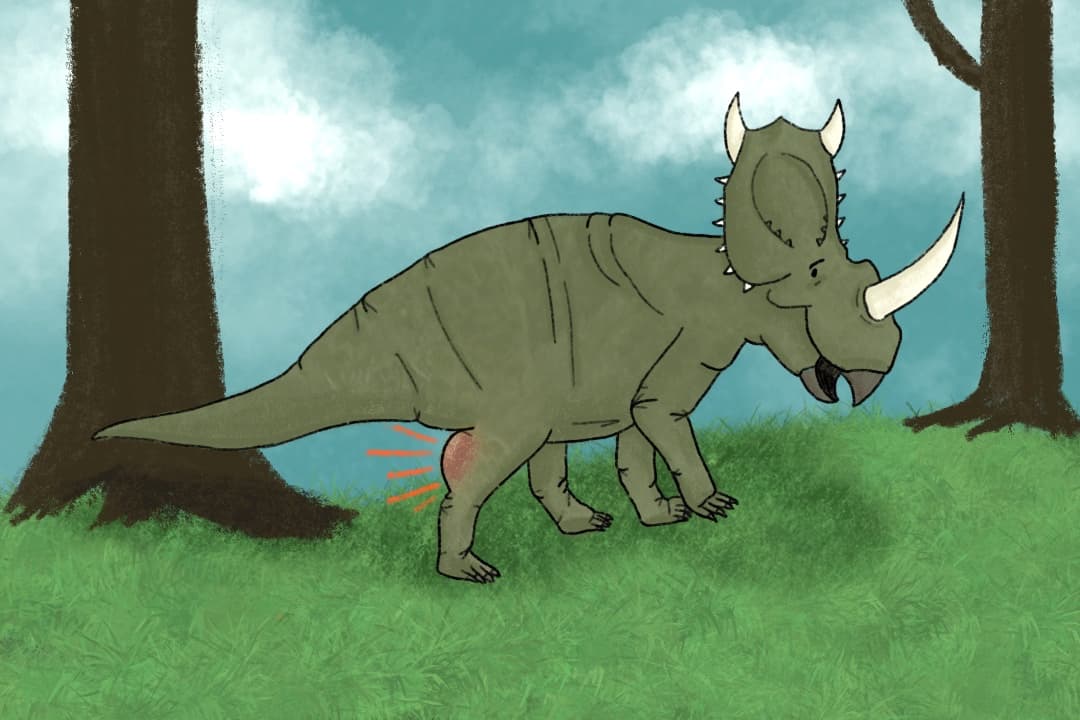Cancer is one of the leading causes of death in Canadians — one estimate suggests that almost half the nation’s population is expected to have cancer in their lifetimes. But cancer does not only affect human beings.
An article in the Wellcome Sanger Institute blog explains that although some species like the bowhead whale and the naked mole rat are resistant to the disease, certain animals like dogs and clams can get cancer.
On August 1, a study co-authored by a U of T associate professor and published in The Lancet Oncology detailed the findings of the first identified case of osteosarcoma, a type of bone cancer, in a dinosaur fossil — specifically, in a fossilized leg bone from a Centrosaurus apertus, a herbivore in the same family as the more commonly-known Triceratops. This fossil is estimated to be 70–75.5 million years old.
David Evans from the Department of Ecology & Evolutionary Biology, and the Temerty Chair in Vertebrate Palaeontology at the Royal Ontario Museum (ROM), was the U of T-affiliated author involved in the study.
How do you diagnose a dinosaur?
This oddly formed fossil was discovered in Alberta in 1989 and was only recently picked for further examination. The tumour was believed to have been a fracture before an interdisciplinary team of researchers, including a paleontologist, a professor of pathology and molecular medicine, and an osteopathologist decided to challenge this claim.
Malignant tumours have never been objectively confirmed in dinosaurs before for a myriad of reasons. Beyond the fact that dinosaur fossils are rare and have undergone preservation, they lack soft tissue samples.
Doctor-approved patient information from the American Society of Clinical Oncology explains how in humans, a cancer diagnosis is made through collecting a biopsy and analyzing the tissue. The pathologist checks the types of cells and how they are arranged in the tissue, and checks for any abnormalities. In the case of the Centrosaurus apertus, which hasn’t possessed live tissue in over 76 million years, scientists had to take a more complex approach.
The “multimodal” approach the team took used a number of distinct diagnostic techniques. A press release from the ROM explained the methodology behind the approach, describing it as a structural analysis accomplished through a three-dimensional reconstruction of the way that the cancer may have spread to help visualize the tumour; the researchers also used a microscope to observe thinned samples of the fossil.
The team analyzed a healthy fibula of another Centrosaurus apertus along with a human fibula of an osteosarcoma amputee and the fibula of the Centrosaurus apertus in question. Similarities were found amongst the Centrosaurus apertus’ fibula and the human cases of osteosarcoma, such as immature bone development.
They found that the Centrosaurus apertus’ tumour failed to follow the traditional patterns of bone growth. This discovery refuted the initial belief that the abnormality was simply a healed fracture, which helped confirm this new hypothesis of osteosarcoma.
Technique’s success might lead to more discoveries
The severity of the lesion also gives scientists reason to believe that the cancer was prominent in that Centrosaurus apertus for an extended period of time and could have spread to other body parts.
Evans told The Globe and Mail, “It’s like a needle in a haystack… You need the cancer to have progressed to the point where it manifests on the bone, and then you need the bone to have been preserved.”
It might be a statistical anomaly that the researchers were able to discover the first case of cancer in a dinosaur. However, now that techniques have been successful, this groundbreaking discovery will lead scientists to search for other forms of the disease amongst extinct species. Their study called for an increase in the use of the “multimodal” approach when attempting to identify atypical lesions on fossils.
Further research on these abnormal fossils will allow paleontologists to understand more about the creatures that came before us, and potentially open up the possibility of further innovations in cancer research.


